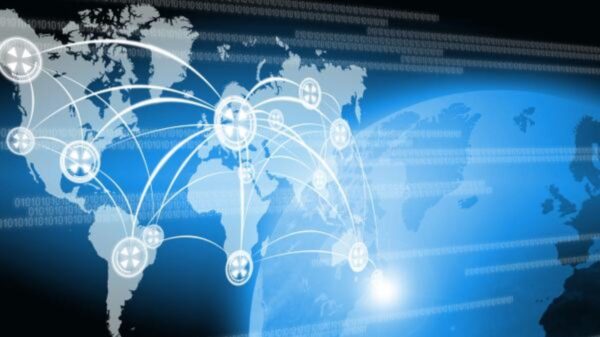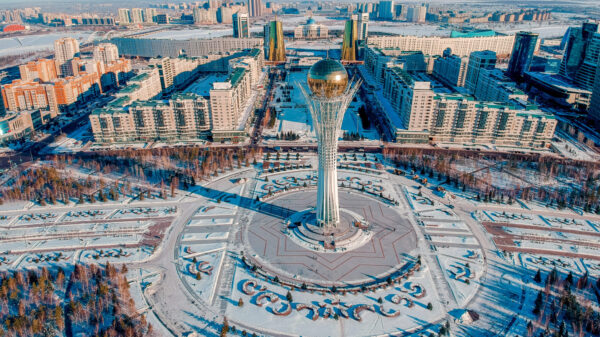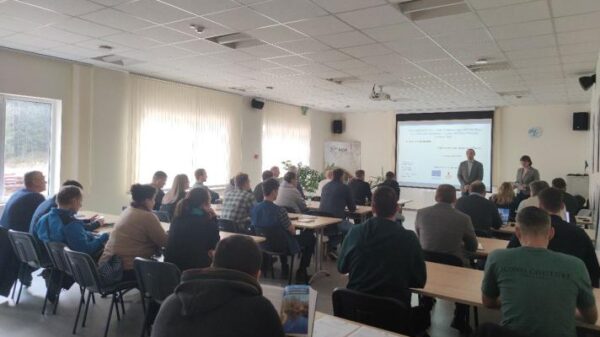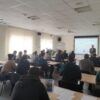I grew up in a land of lies and bones, with the dead being erased or subsumed by the Kremlin, which refused to see Ukraine as a nation, imposing a Soviet identity over us all.
Today, we’re witnessing the same nihilistic violence unfold in real time, in a campaign of bullets and bombs dropped over Ukraine. “I’m OK,” terrified friends in Kharkiv and Kyiv keep telling me. What else is there to tell? We know this war isn’t new; in some ways we have always expected it to resume.
I remember the pockmarks. My father and I were coming home after a walk in a small park filled with lilacs near our apartment in Kharkiv (then called Kharkov) when Ukraine was still a Soviet republic. “Why are there holes there?” I asked my father, pointing to a cluster of ugly craters, chipped into a corner of our apartment block.
“It’s from the war,” he told me. It was the mid-1980s, nearly half a century after World War II had ended. The artillery scars are still in my mind. It’s one of my earliest childhood memories.
It was impossible to grow up in Ukraine without witnessing the violence the land had seen. We clambered around old tanks proudly displayed in parks and squares, lumbering monuments to World War II. We learned of this history at dinner tables and in elementary schools, in stories passed down of famine and invasions, from the Mongol destruction of Kyivan Rus in the 13th century to the Nazi attack in 1941 to the Soviet purges.
By the 1980s the country was in many ways a giant mass grave, a grave the size of Texas. And yet we were not encouraged to see it as a Ukrainian story, but as a Soviet one, a collective amnesia pushed out from the Kremlin across the Soviet states.
The story of modern Ukraine begins a little over 100 years ago, at the end of World War I, when new states were crawling out of the ruins of defeated empires across Europe. Ukraine, however, was fractured. The region ended up in two pieces: the eastern and central parcels were annexed by the Soviet Union; the western region, known as Eastern Galicia, which had once belonged to the Austro-Hungarian Empire, was tacked on to Poland. Both were about to enter decades of suffering.
Warsaw, which had just regained its sovereignty for the first time in 123 years, wasn’t keen on permitting a distinct Ukrainian identity to develop in Eastern Galicia; the 1920s saw an increasing crackdown on Ukrainian culture, churches and schools. When Ukrainian nationalists began waging a campaign of terrorism and assassination against what they viewed as a Polish occupation of Ukrainian soil, Warsaw responded with the 1930 “pacification of Eastern Galicia,” a euphemism for brutal suppression of Ukrainians.
But the situation in Poland paled in comparison to the genocide Stalin perpetuated on the Soviet part of Ukraine. From 1932 through 1933, Soviet commissars began seizing grain and food from Ukrainian peasants in the name of Communist collectivization, part of a vicious backlash against the independent farmers whom Moscow deemed to be too successful and therefore too greedy.
The seizure of food turned Ukraine into an apocalyptic wasteland plagued by famine. People dropped dead on the streets. Ukrainians ate dirt, grass, food waste. Reports of cannibalism were widespread, and parents were said to have eaten their children. About 3.9 million Ukrainians perished in what became known as Holodomor — “death by hunger” in Ukrainian. But killing them wasn’t enough. As a final insult, Stalin, who was infamous for erasing enemies from photographs, forbade talk of the famine and ensured statistics were altered to hide the deaths, as if his victims had never existed.
Less than a decade later, the Nazis seized Ukraine. Some 1.5 million Ukrainian Jews were killed, most by mobile Nazi death squads known as Einsatzgruppen, aided by local collaborators in what later became known as the Holocaust of bullets. Babyn Yar, just outside of Kyiv, became the final resting place for 33,000 Jews mowed down in just days. Destruction was not limited to the Jews. Cities, including Kharkiv, were reduced to swaths of rubble. Over two million Ukrainians were pressed into slave labor in Germany. Hunger descended again. In all, due to war and famine and destruction, five million to seven million Ukrainians lost their lives. Nearly 200,000 Crimean Tatars, Muslims who lived in Ukraine for centuries, were deported to Central Asia; tens of thousands died as a result.
The end of German occupation didn’t end the suffering, it only brought renewed Soviet repression. The U.S.S.R. couldn’t abide any identity that challenged Soviet dominance, whether in individuals or nations. For 40 years after the war, Russia methodically swept aside the Ukrainian language and culture, leaving behind a landscape of soulless Soviet kitsch, red stars and slogans and tomes of speeches by Lenin. Ukrainian identity was vestigial and subservient; I still remember my school showing us drawings of peasants in vyshyvanki — traditional Ukrainian embroidered shirts — insipidly smiling while waving Soviet flags.
The Kremlin also suppressed Holocaust remembrance, which it saw as potentially dangerous because it facilitated Jewish communal identity. For decades, the bodies of hundreds of thousands of Jews remained strewn in Nazi killing pits throughout Ukraine without so much as a grave marker. When the regime did permit memorials, the dead were invariably referred to as “peaceful Soviet citizens,” their Jewish identity purposefully omitted.
When I was still a child, in 1986, an explosion at the Chernobyl nuclear plant spewed a radioactive cloud through Ukraine and Belarus. Heroic local volunteers and firefighters put out the radioactive inferno, preventing a second explosion that could have decimated half of Europe; many died horrific deaths in the process and in the aftermath. A large area of land was rendered uninhabitable and remains so today. Moscow stifled discussion of Chernobyl as it happened, cloaking the accident in secrecy and propaganda.
Three years later my parents, my grandmother, my sister and I — along with thousands of other Soviet Jews — fled for Vienna. It was from America that we watched, in 1991, as the Soviet Union crumbled and the Iron Curtain was drawn back. Ukraine gained its independence, but promises of democracy were soon mired in endemic corruption.
In 2004, the Orange Revolution saw hundreds of thousands of Ukrainians reverse the outcome of a fraudulent presidential election. In the winter of 2013-14, millions joined the Euromaidan uprising, demanding that Ukraine enter into a partnership agreement with the European Union. Shortly after, Russia illegally annexed the Crimean peninsula while Russian-backed separatists launched an anti-Euromaidan uprising in the east of the country.
I wonder if our old pockmarked apartment building in Kharkiv has new scars, if it’ll even be standing tomorrow. My American friends were emailing and texting, expressing sympathy, asking what they could do. I didn’t respond to some of them; I couldn’t. America wants solutions and happy endings, and I couldn’t tell my friends the reality — there’s nothing they or I can do.
But that isn’t entirely true. President Vladimir Putin of Russia, who denies that Ukraine is a sovereign nation, is waging far more than a physical war: He, like his predecessors in the Kremlin, is working to erase the very concept of Ukraine from existence. With each new report of a Russian bombing, I find myself becoming more Ukrainian, seizing the identity that first the Soviet Union — and now Russia — has long fought to suppress.
I hope others can help keep Ukraine alive. Learn the history. Light a candle on Holodomor Remembrance Day in November. Mourn the dead. Remember Ukraine.
Lev Golinkin is the author of the memoir “A Backpack, a Bear and Eight Crates of Vodka.”
The Times is committed to publishing a diversity of letters to the editor. We’d like to hear what you think about this or any of our articles. Here are some tips. And here’s our email: letters@nytimes.com.
Follow The New York Times Opinion section on Facebook, Twitter (@NYTopinion) and Instagram.




























